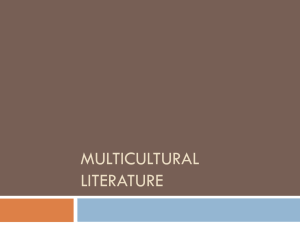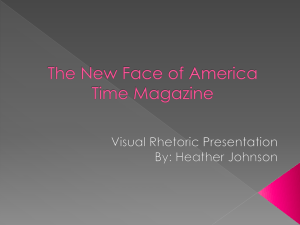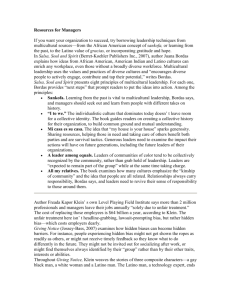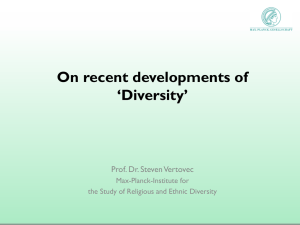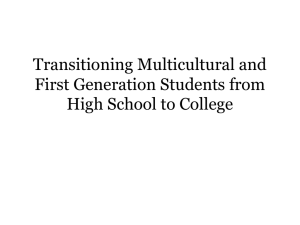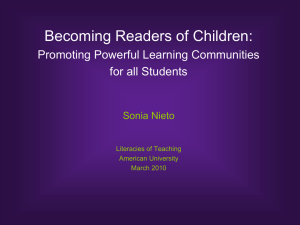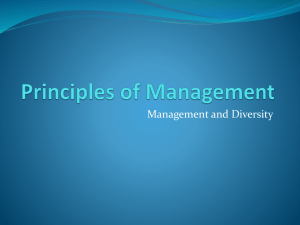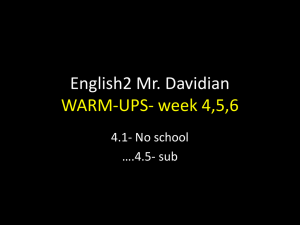don`t judge a book by its cover
advertisement
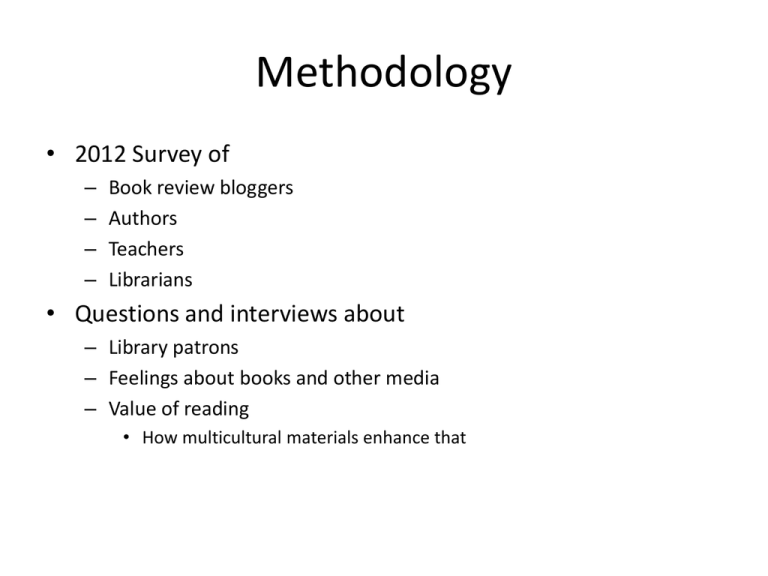
Methodology • 2012 Survey of – – – – Book review bloggers Authors Teachers Librarians • Questions and interviews about – Library patrons – Feelings about books and other media – Value of reading • How multicultural materials enhance that Why do we care? • The world is getting smaller • The 2012 Olympics gave us stories of valor and identity from around the world. – We rooted for people vastly different from ourselves • Kids have some exposure through film, TV, the Internet. But a good book does more. – Involves the reader – Forces them to think – Helps them see moral and ethical dilemmas and the results of choices. • Inclusion - the extent to which different voices and perspectives are heard/shared. Defining the issue • Multicultural – For me, it’s how the different cultures make up the individual community. – Multi-cultural is an awareness/acceptance of more than one language and culture. – Books that represent a diversity of societal viewpoints. – The presence of a variety of cultures; including but not limited to ethnic, religions, sexual orientation, ability variances each of which has its own unique culture – Materials that share "stories, facts, and customs from around the globe" (and around the nation) that allow "children to become familiar with diversity and to become comfortable with adjusting to the unfamiliar" • (from Venture into Cultures: A Resource Book of Multicultural Materials and Programs, Second Edition). Defining the issue • Diversity: “Different from me” in terms of – – – – – – – Gender Race Sexual orientation Ability Ethnicity Country/society of origin Background What is the value of reading? • • • • • • • • • Empathy Knowledge/Acquisition of information Critical thinking/Examining values Broadening world view/acquiring a global perspective Fun Self-validation, self-worth Understanding yourself/your place in life Developing practical reading skills “I want my readers to find pleasure, as well as comfort, company, information, inspiration and empowerment.” Those characters don’t represent the demographics my library serves • Are you sure??? And does it matter?? • We are a nation of different cultures. And the world is getting smaller • Just having multicultural books available, on the shelves, shows your students that you value all people and cultures – More to it than just purchasing materials that reflect the demographics within your specific community, their heritages and backgrounds. – Inclusion means more than just giving patrons what they ask for or "profiling" reader likes based on age, race, cultural background, and/or gender. How do we find the material? • Good news – you may already have more than you realize • Multicultural books are not necessarily advertised as such. In fact, sometimes that information is deliberately hidden from prospective buyers. – Don’t just judge the book by the cover – it may mean much less than you think French Australian U. K. U. S. U. S. Covers • That maxim of “don’t judge a book by its cover” is still true. • On her blog, Larbalestier author of LIAR, wrote: – Editors have told me that their sales departments say black covers don’t sell. Sales reps have told me that many of their accounts won’t take books with black covers. Booksellers have told me that they can’t give away YAs with black covers. Authors have told me that their books with black covers are frequently not shelved in the same part of the library as other YA—they’re exiled to the Urban Fiction section—and many bookshops simply don’t stock them at all. • How welcome is a POC, a person with a disability, or GLBT going to feel in a section where all the covers feature a single culture where they have little or no place? Partnerships • • Share your programming ideas with potential partners and see if your goals resonate with any of them. Possible partner organizations might include: – – – – – – – – – Arts and humanities organizations (historical societies, museums, cultural centers) Book clubs Area religious and interfaith organizations Professional associations School districts / Community colleges / Universities Writers groups and poetry guilds Local businesses Minority group associations Indiana black librarians network • Examples – Center for Teaching through Children's Books - http://www.nl.edu/t4/ctcb/ • a partnership between National Louis University Library and National Louis University College of Education. – Example – Suburban Mosaic Project http://www.suburbanmosaicbooks.org/ How do you find materials? • • • • • Reviews ALA awards Word of mouth Covers Authors you know (Hope you now feel you know me) Promoting the collection • Many people still believe that books about people of color or LGBT people are only for readers who are also people of color or LGBT. This is a sad but incontrovertible truth. We can’t ignore this. It’s necessary to market to the masses. – Booktalks to promote issues – Shelf displays (do more than just the “designated months”) • Taking to the streets (even figuratively) and shouting about the need for equality is something that needs to be done, and is being done by many people today. - http://www.malindalo.com/2011/01/dont-judge-a-book-by-itscover/ • Remember, a good story is a good story – Showcase a variety of titles - make great new books irresistible. We librarians are more like used-car salesmen than we ever want to admit! Direct access to the creators • The internet reduces the distance between producer and consumer – Publisher, publicist, distribution, even reviewers • Direct access to authors – We all have websites – Indie authors • SCBWI – Speakers bureau http://www.scbwi.org/Pages.aspx/Speaker-Bureau • Grab your local authors – SCBWI – RWA – MWA Favorite Authors • Black – – – – – – – – – Celeste Norfleet Angela Jackson B. A. Binns Beverly Jenkins Sharon Flake The McKissacks Sharon Draper Jacqueline Woodson Patricia McMissock • GLBT – Melinda Yo – Julie Ann Peters • Hispanic – Matt De La Pena – Torry Maldonado – Pam Muñoz Ryan • Other – Neesha Meminger – Brenda Stanley • Asian – Cynthia Liu – Lisa Yee – Linda Sue Parks Publishers • James Lorimar & Co, LTD - http://www.lorimer.ca/childrens/childrens-home.html – Emphasis on reluctant readers and on diversity • Cinco Puntos Press - http://www.cincopuntos.com/products.sstg?id=3 • based in El Paso, Texas. Like most independent houses, it goes for the quality over quantity approach. Native American and Spanish esp. • Albert Whitman & Company - http://www.albertwhitman.com/content.cfm/multiculturalbooks • Lee & Low Books - http://www.leeandlow.com/ • The company's mission to meet the need for stories that all children can identify with and enjoy with a focus on diversity. – Tu books – S/F, Mystery, Fantasy – ARCOIRIS – Spanish language – Children's Book Press – literature for children by and about people from the Latino, African American, Asian/Pacific Islander, and Native American communities. • AllTheColorsOfLove press – http://allthecolorsoflove.com Awards • Use awards geared toward diversity to find books, as well as the ALA awards – 28 days later - http://thebrownbookshelf.com/ – Burt Award for African literature http://www.codecan.org/getinvolved/burt-award-africa – Cybil awards (Children and Young Adult Bloggers literary awards) – www.cybils.com – New Voices is an award for picture books written by writers of color by Lee & Low books. – Independent publisher awards (IPPY) • http://www.independentpublisher.com/article.php?page=1534 • Both adult and juvenile multicultural categories Reviews • In addition to the “big guys” take a look at other sources for reviews • Independent bloggers – http://americanindiansinchildrensliterature.blogspot.com/ – http://thebrownbookshelf.com/ – African books - http://bookshybooks.blogspot.com/ – http://www.papertigers.org/home.html - focus on pacific rim and South Asia – http://campbele.wordpress.com – International Board on Books for Young People – http://www.ibby.org/index.php?id=266 My blog/reviews http://harperwriterstogether.blogspot.com/search/label/Multicultural • Goodreads http://www.goodreads.com/list/show/9688.YA_Books_With_Minorities Survey comments • Give readers an opportunity to view concepts, events, and issues from more than just the perspective of the mainstream group. Otherwise people gain only a limited view of the world. When the world is viewed from more than one perspective, readers gain insight into their own behavior – Creating an awareness of "others" is a step toward fostering empathy and recognizing a different way of living and communicating. – Every time someone reads a book about a character who is different from them— even if they didn’t know it going into it — that reader’s universe is broadened a little. – I believe that when readers identify with characters from different backgrounds, they can come to realize that different isn't wrong, that different can be fascinating. – It’s comforting and empowering for anyone to see his or her cultural experience reflected in literature. And for general population readers, it’s an essential tool to appreciating/celebrating the differences among us, as well as understanding the similarities. • I think it is important for children who live in the dominant culture to see that there are a variety of ways of living and being, but that at our core, we are all so very similar. Examples • The Dogs of Winter—Set in Russia in the mid 1990s with a culture and country quite foreign to most American kids, but containing universal themes (family, love, self worth) all kids can identify with. – The Dogs of Winter (Arthur A. Levine Books/Scholastic) Bobbie Pyron ISBN: 978-0-545-39930-2 • This Thing Called The Future – Set in present day Africa, a girl has to deal with dying relatives and the unwanted attentions of an older man while trying to reach her dream of an education. – This Thing Called the Future (Cinco Punto Press) J. L. Powers ISBN 9781933693958


